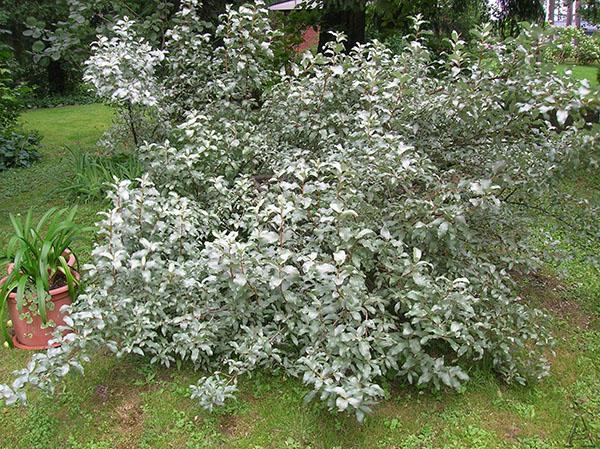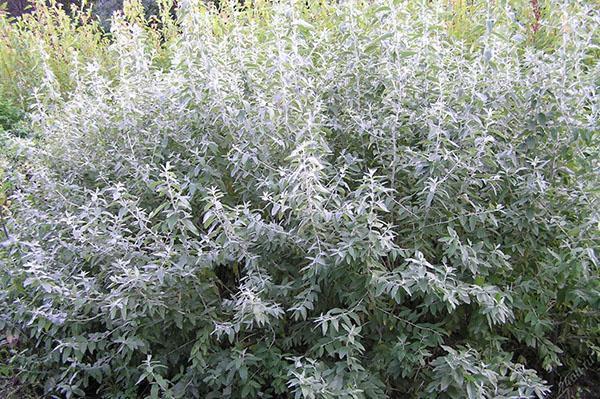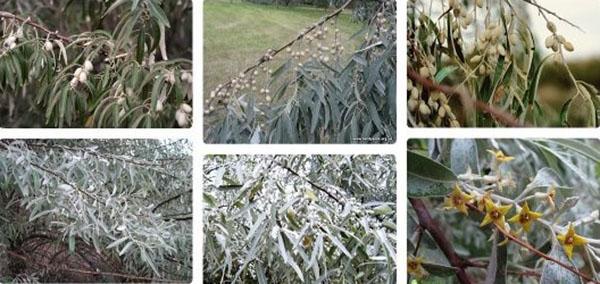Simple cultivation of silver sucker in the garden
 Cultivation of silver sucker is popular all over the world. In nature, there are more than 50 plant species, which is a relative sea buckthorn... The homeland of the silver sucker is the lands of China.
Cultivation of silver sucker is popular all over the world. In nature, there are more than 50 plant species, which is a relative sea buckthorn... The homeland of the silver sucker is the lands of China.
External characteristics of silvery sucker


Common varieties:
- Zempin;
- Quicksilver;
- Narrow-leaved oak (Elaeagnus angustifolia).
Loch can be called a shrub or a small tree, which reaches a height of no more than 5 m. The crown is wide with long leaves, the surface of which is silver-plated.
 Even in winter, the plant looks beautiful due to its unusual shape and brown branches. The flowering of the plant falls at the beginning of summer and lasts about 20 days. The shape of the buds is a bell, they are yellow and small, exude a delicate vanilla aroma. The fruits ripen by the end of summer. They have a specific taste and are edible. The plant can withstand severe frosts.
Even in winter, the plant looks beautiful due to its unusual shape and brown branches. The flowering of the plant falls at the beginning of summer and lasts about 20 days. The shape of the buds is a bell, they are yellow and small, exude a delicate vanilla aroma. The fruits ripen by the end of summer. They have a specific taste and are edible. The plant can withstand severe frosts.
Growing silvery sucker
 In order for a beautiful silver goose bush to appear on the site, it is necessary to choose the right place, plant the seedling in a timely manner and provide it with good care.
In order for a beautiful silver goose bush to appear on the site, it is necessary to choose the right place, plant the seedling in a timely manner and provide it with good care.
Suitable period for planting
There are several methods of plant propagation, and depending on the method chosen, the planting period will differ. Seeds are sown in the ground in the fall. As for the cuttings, they are planted in early June. In early spring, layering can be done.
Saplings are planted in late autumn or early March. An important aspect: the soil for planting must be well moist, because in the early stages of growth, the sucker really needs water.
Choosing a place and preparing the ground
 Silver loch loves sunlight most of all, so it is best to choose an open area for it. Although the plant will grow well in partial shade. If there is a hill in the southern part of the site, plant the plant there.
Silver loch loves sunlight most of all, so it is best to choose an open area for it. Although the plant will grow well in partial shade. If there is a hill in the southern part of the site, plant the plant there.
The bush must be hidden from strong winds, so a fence can be installed.
As for the composition of the soil, it is not particularly important for the sucker. The only important point is the acidity requirement. If the indicators are large, then the plant will develop slowly.
Another measure of preparing the soil for planting a plant is a thorough digging, leveling the earth, removing roots, weeds and debris. The sucker has a fibrous root system - the root is not deepened.
Planting a plant
 The plant should be planted in a pre-prepared hole, the depth of which is approximately 50 cm, and the diameter is 1 m. The bottom is covered with a drainage layer: screening, sand, crushed stone, small stones are suitable. Appointment drainage is to protect the roots of the plant from decay due to constant moisture. Soil is placed on the drainage layer, into which a natural fertilizer is added - leaves, humus or compost. Superphosphate or wood ash (about 300 g) is also suitable as a top dressing.
The plant should be planted in a pre-prepared hole, the depth of which is approximately 50 cm, and the diameter is 1 m. The bottom is covered with a drainage layer: screening, sand, crushed stone, small stones are suitable. Appointment drainage is to protect the roots of the plant from decay due to constant moisture. Soil is placed on the drainage layer, into which a natural fertilizer is added - leaves, humus or compost. Superphosphate or wood ash (about 300 g) is also suitable as a top dressing.
When the soil is ready, a seedling can be placed in the hole, carefully sprinkling it with earth so that the root is completely below the surface of the soil. After filling the hole, the soil must be trampled, watered with plenty of water and mulched. Thus, it will be possible to retain moisture and protect the sucker from weeds.Two meters is the optimal distance between bushes.
Care in the process of growing
After planting, the plant should be cared for. The plant can grow well in any soil, and the impact on it of pests and diseases characteristic of our climate is minimal. For the full growth and development of the sucker, it should be watered regularly, the soil around the trunk should be loosened. Loosening can be done rarely if the soil was mulched with sawdust or dry grass before planting.
Watering the plant
 The plant belongs to drought-resistant species, but, despite this, you should not take long breaks between waterings. Regular watering of young bushes is especially important. Watering is important based on the type of plant root system: since the roots are closer to the surface, they do not reach the groundwater, therefore, they may suffer from a lack of nutrient moisture. In this regard, if there has been no rain for a long time or there is intense heat, the plant should be regularly watered. Watering should be moderate, water should not stagnate in the soil and on its surface. If there is too much water, the roots will start to rot.
The plant belongs to drought-resistant species, but, despite this, you should not take long breaks between waterings. Regular watering of young bushes is especially important. Watering is important based on the type of plant root system: since the roots are closer to the surface, they do not reach the groundwater, therefore, they may suffer from a lack of nutrient moisture. In this regard, if there has been no rain for a long time or there is intense heat, the plant should be regularly watered. Watering should be moderate, water should not stagnate in the soil and on its surface. If there is too much water, the roots will start to rot.
Top dressing
 Top dressing is required for shrubs only when it grows on very poor soil. And so, as a rule, they fertilize the plant at the time of planting the plant in the ground. Further feeding is recommended to be done once a year. For this, organic fertilizers are most suitable - humus, compost. You can also use superphosphate. It is not recommended to take nitrogen compounds.
Top dressing is required for shrubs only when it grows on very poor soil. And so, as a rule, they fertilize the plant at the time of planting the plant in the ground. Further feeding is recommended to be done once a year. For this, organic fertilizers are most suitable - humus, compost. You can also use superphosphate. It is not recommended to take nitrogen compounds.
Reproduction methods
 The plant can reproduce by cuttings, seeds, dividing the bush, parts of the rhizome, branching.
The plant can reproduce by cuttings, seeds, dividing the bush, parts of the rhizome, branching.
Most often, gardeners use the second option. It is recommended to place seeds in the ground in spring or October. The grains require stratification, otherwise the growth rates will be very low.
If reproduction is done by layering, then we take the most solid branch from the bottom of the bush. It is bent to the ground, fixed and covered with soil. It is best to do this in the spring, and water it until late autumn. The main thing is to prevent stagnation of water. The branch is separated from the main bush at the end of November.
A stalk can be a long shoot (12-18 cm), which has few buds. It should be covered with a solution to accelerate growth, placed in a box of wet sand. This procedure is carried out at the beginning of summer: the shoot is regularly watered so that it does not dry out.
Shrub shearing
 The only drawback is the slow growth of the bush. Only if the sucker grows in good quality soil, then it can stretch by 0.5 m in a year. In this regard, pruning is carried out once a year. The formation of the crown in the sucker is easy, the plant tolerates the procedure well. The owner can choose any appearance depending on his preferences. The plant can be left as a shrub, or you can make a standard tree out of it.
The only drawback is the slow growth of the bush. Only if the sucker grows in good quality soil, then it can stretch by 0.5 m in a year. In this regard, pruning is carried out once a year. The formation of the crown in the sucker is easy, the plant tolerates the procedure well. The owner can choose any appearance depending on his preferences. The plant can be left as a shrub, or you can make a standard tree out of it.
In addition to cutting, old shrubs should be carefully trimmed to form the crown shape.
A shrub that has turned more than 10 years old needs to be freed from time to time from old branches, giving room to young growth. This event will allow the plant to delight you with its appearance for another 15 years without requiring a transplant.
Despite the slow growth, the shoots from the roots of the sucker appear very quickly. They should be detected and removed in a timely manner, otherwise they will draw vitality from the bush, and it will turn into a miserable semblance of a beautiful plant, losing its decorative effect.
Plant in landscape design
 Silver loch is very beautiful in appearance, therefore it is often used in decorative compositions.
Silver loch is very beautiful in appearance, therefore it is often used in decorative compositions.  After the leaves fall, in winter the bush remains with silver fruits, giving it an original appearance.
After the leaves fall, in winter the bush remains with silver fruits, giving it an original appearance.  Therefore, the plant does not look naked and empty in the cold season.
Therefore, the plant does not look naked and empty in the cold season.